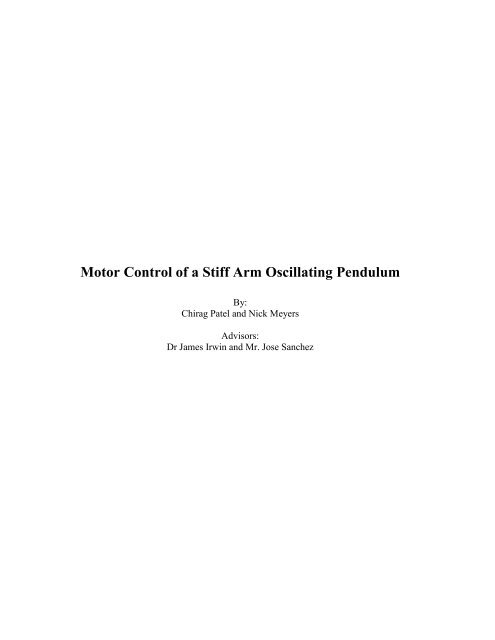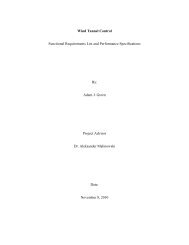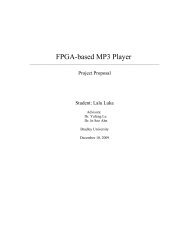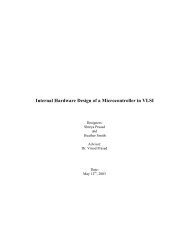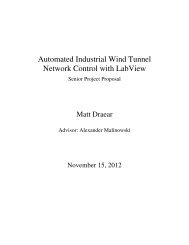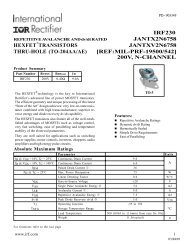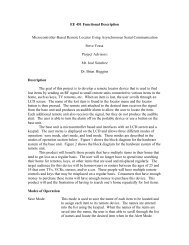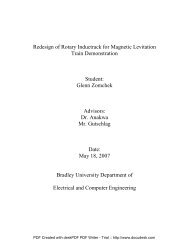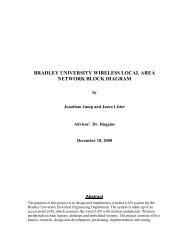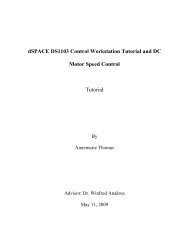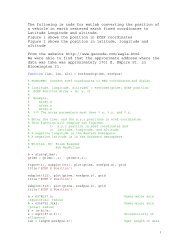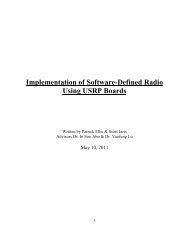Motor Control of a Stiff Arm Oscillating Pendulum
Motor Control of a Stiff Arm Oscillating Pendulum
Motor Control of a Stiff Arm Oscillating Pendulum
Create successful ePaper yourself
Turn your PDF publications into a flip-book with our unique Google optimized e-Paper software.
<strong>Motor</strong> <strong>Control</strong> <strong>of</strong> a <strong>Stiff</strong> <strong>Arm</strong> <strong>Oscillating</strong> <strong>Pendulum</strong><br />
By:<br />
Chirag Patel and Nick Meyers<br />
Advisors:<br />
Dr James Irwin and Mr. Jose Sanchez
Functional Description: <strong>Motor</strong> <strong>Control</strong> <strong>of</strong> an <strong>Oscillating</strong> <strong>Pendulum</strong><br />
Objective: To design and build a motor controlled oscillating stiff arm pendulum that will be capable <strong>of</strong><br />
initiation and termination <strong>of</strong> the oscillation based upon the user command, as well as achieve various<br />
heights and speeds to be selected by the user.<br />
Description: We have decided to design and build a motor controlled oscillating pendulum. The initial<br />
design will include only one height, however, if time permits the user will be allowed to select the<br />
swinging height <strong>of</strong> the pendulum which will be dependent upon the number <strong>of</strong> sensors. The user will also<br />
be allowed to select the start and the termination <strong>of</strong> the oscillation system. The general block diagram for<br />
the system can be seen in Fig 1. The pendulum will be controlled by short bursts from a DC motor. We<br />
will design the burst <strong>of</strong> the motor to occur when the pendulum swings past the equilibrium point by<br />
placing a sensor at our equilibrium point to act as the burst sensor. Once the pendulum has reached the<br />
predefined height (through feedback from the sensor at that predefined height) the pendulum will continue<br />
to oscillate at that frequency until the user selects the option to terminate the oscillation, at which time, the<br />
pendulum will slowly return to equilibrium. Our initial design will have a predefined height with only one<br />
sensor. If time permits we will place several sensors along the oscillation <strong>of</strong> the pendulum. A 12 Volt DC<br />
motor will be used to generate the oscillation <strong>of</strong> the pendulum. However the pendulum will be selected in<br />
order to place strain upon the DC motor. For example, if the motor has a maximum torque <strong>of</strong> 20 oz/in,<br />
then a pendulum will be selected that will require 25oz/in. Also, the motor will be underpowered with<br />
respect to the power supply. Circuitry will have to be designed in order to store power between the motor<br />
bursts. A more detailed full system block diagram can be seen in Fig 2. The s<strong>of</strong>tware will be used to send<br />
the signals to the motor in order to control the bursts according to the input <strong>of</strong> the user and the feedback <strong>of</strong><br />
the sensors. A s<strong>of</strong>tware flow chart can be seen in Fig 3. In addition to the single stiff arm pendulum, we<br />
will place a second stiff arm pendulum that will hang from the first in order to place a greater load on the<br />
DC motor as well as complicate the control <strong>of</strong> the system.<br />
User Selected Start/Stop<br />
User Selected Height<br />
DC <strong>Motor</strong>/<br />
Microcontroller/<br />
<strong>Pendulum</strong><br />
System<br />
<strong>Pendulum</strong> Oscillation<br />
Fig. 1: Block Diagram <strong>of</strong> the <strong>Oscillating</strong> <strong>Pendulum</strong> System
User Input<br />
8051<br />
Microcontroller<br />
Board<br />
MAINTAIN BURST<br />
VELOCITY<br />
EMAC to<br />
Hardware<br />
Interface<br />
Optical Sensors<br />
DC<br />
<strong>Motor</strong><br />
Power Supply<br />
12 Volt<br />
DC<br />
<strong>Motor</strong><br />
Fig. 2: Full System Block Diagram<br />
USER INPUT<br />
LCD USER PROMPT<br />
STORE KEYPAD<br />
ENTRY<br />
BEGIN MOTOR<br />
BURSTS<br />
OPTICAL SENSOR<br />
READING<br />
COMPARE SENSOR<br />
READING TO STORED<br />
HEIGHT<br />
Fig. 3: S<strong>of</strong>tware System Flow Chart<br />
<strong>Stiff</strong><br />
<strong>Arm</strong><br />
<strong>Pendulum</strong><br />
INCREASE BURST<br />
VELOCITY<br />
<strong>Pendulum</strong><br />
Swing<br />
Height


